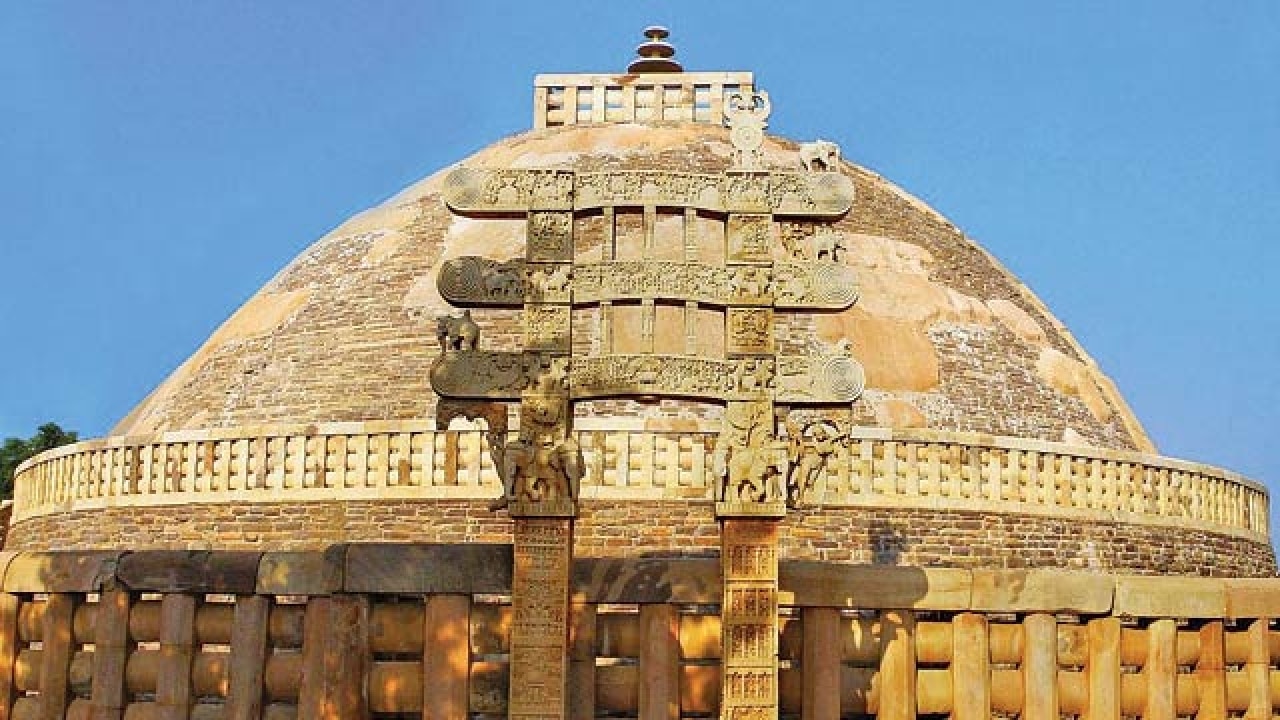
The rain clouds have flooded the sky. In another 10 days the Satpuras and the Vindhyas will be green; dried-up channels and streams will come alive. The heavens washed clean of the dust, smoke and grime will turn azure again; the blue accentuated by the fluffy white cumulous clouds riding the easterlies. This is the time to travel to Abu, Ajanta, Bhimbetka, Bhojpur, Bodhgaya, Ellora, Mandu, Rajgir, Udaigiri and, of course, Sanchi.
Reach Sanchi as early as you can, many trains stop at the sleepy, two-platform Sanchi Station. The Great Stupa is within a 20-minute walk, barely one-and-a-half kilometre, of which the last 400 metres is up a motorable hill road. You may also drive from Bhopal, skirting the strikingly green Satpuras covered in teak, palash, mahua, kaith, and other broad leaves of Central India, bursting into new growth come the rains.
Start from Bhopal at 5 am, take a tea break on a roadside stall to reach by 7, be among the first and have the entire complex at your disposal.
You need to have time before the sun becomes too hot, carry your umbrellas as protection, against both rain and sun, for there is little shelter among the remains, but a plenty to see, in fact almost 50 structures, big and small including three main stupas, several smaller stupas at a lower level, remains of a huge water tank, numerous small niche temples and viharas, the remains of a large temple that transports you to Greece, large pieces of what must have been a stunning Asokan Pillar, images of the Buddha and the Jatakas, real and mythical animals and Salabhanjikas carved on the four gates added by the Satvahanas.
The foundation stone for the stupa was laid by Asoka the great in the third century BCE. He also organised the distribution of the relics of Buddha to be placed at various locations to promote Buddhism. The hill was chosen, because it dominates the landscape for miles, and also because of its proximity to the major trading centre of Vidisha, home to Asoka’s Queen Devi, the daughter of a merchant from that city.
The stupas at Sanchi contained the relics of the Buddha and his close disciples. Emperor Asoka had commissioned the complex and it was located near Vidisha; these three factors combined together turned Sanchi into a major Buddhist pilgrimage. Sanchi witnessed the spread of construction over 1,500 years from the third century BCE to the 12th century CE. Mauryans, Shungas, Satvahnas, Kushanas and the Guptas all contributed to the stupas.
The stupa is believed to have been vandalised in the second century BCE, perhaps in the reign of the Shunga Emperor Pushyamitra, an army general who captured the Mauryan Empire. His son Agnimitra is said to have rebuilt the stupa.
The top was flattened and crowned with three umbrella-like structures, built one on top of the other and placed within a square railing. A double stairway led to a balustrade meant for circumambulation. A similar balustrade at the ground level pierced with four gates, or Toran Dwars, facing the cardinal directions is believed to have been added during the rule of the Satvahanas.
The Shungas commissioned the stupas numbered 2 and 3. Stupa number 2 is the second-most significant structure at Sanchi — it is here that the relics of the two senior-most disciples of the Buddha, Sariputta and Maha Moggallana, were discovered, in 1851 by Alexander Cunningham, the founder of the Archaeological Survey of India and its first Director General.
The relics were removed and taken to London and placed within the Victoria and Albert Museum. It were the combined efforts of the Maha Bodhi Society, Prime Minister Jawahar Lal Nehru and the Last Nawab of Bhopal, starting in 1937 and culminating in 1947, because of which the relics were finally brought back to India and placed in the newly built Chetiyagiri Vihara, by Prime Minister Jawahar Lal Nehru in November 1952.
The Great Stupa at Sanchi, inscribed on the World Heritage List, is the earliest-built stone structure in India. Reason enough to pay her a visit — once there, you will realise the loss of those who haven’t been there.
The author is a historian and organises the Delhi Heritage Walks